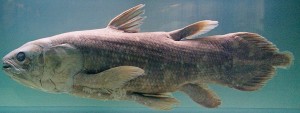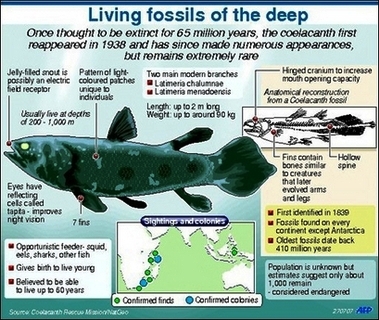Coelacanth is a rare order of fish. The two extant species include the West Indian Ocean Coelacanth (Latimeria chalumnae) and the Indonesian Coelacanth (Latimeria menadoensis). They follow the oldest known living lineage of Sarcopterygii (lobe-finned fish and tetrapods); this classification means they are more closely related to lungfish, reptiles and mammals than to the common ray-finned fishes. The species are the most endangered order of animals in the world. Both species are threatened with the The West Indian Ocean Coelacanth classified as a critically endangered species. Coelacanths have been found along the coastlines of the Indian Ocean, Indonesia, and Tanzania.
Coelacanths are of extreme evolutionary importance as they have supposedly remained morphologically unchanged for millions of years. Some call coelacanths “living fossils.” Although some more recent studies have shown that coelacanth body shapes are much more diverse than generally thought and therefore may not have as significant a lack of evolution over the past millions of years as originally thought, coelacanths are still an incredible find. Coelacanths predate dinosaurs and it was believed coelacanths had gone extinct in the Late Cretaceous period until one was discovered in 1938 off the coast of South Africa; prior, the only proof of coelacanths were ancient fossils.
It’s ancestors date back more than 400 million years – a time when all creatures lived under water and about the time right before the great transition to living on land. Some have called the coelacanth with its fleshy, leg-like fins the missing link in evolution from fish to land animals.
Coelacanths are rather large and average about 1.6 meters in length. They have large, lobed fins that look like legs. Together with lungfishes, coelacanths are the nearest relatives to vertebrates which took the first step on land 350 million years ago. This close biological link with four-legged animals have made coelacanths not only an important evolutionary species, but also a public object of fascination. Instead of a vertebral column, coelacanths retain a notochord, a hollow, pressurized tube. The coelacanth has eight fins – 2 dorsal fins, 2 pectoral fins, 2 pelvic fins, 1 anal fin, and 1 caudal fin. The coelacanth braincase is only filled 1.5% with brain tissue with the remaining 98.5% filled with fat.






 Twitter
Twitter LinkedIn
LinkedIn Youtube
Youtube RSS
RSS